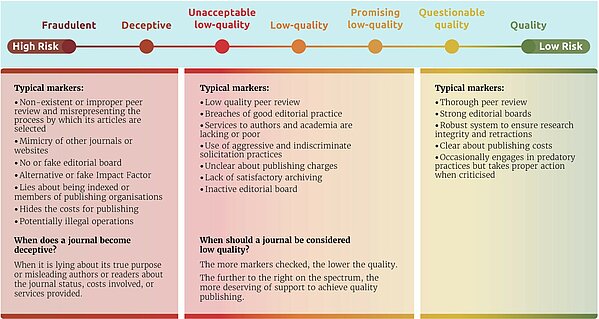Predatory journals and low-quality journals
Predatory journals are journals that prioritise profit (via the payment of APCs by authors) to the detriment of publication quality (weak or non-existent peer-reviewing). They present a risk for authors and for research in general (quality of publications, scientific integrity).
When these journals first appeared in the early 2000s, they were easy to identify in most cases. Now they are increasingly difficult to spot, as they evolve and adapt to look like serious journals.
They can therefore have practices of different qualities, from qualitative to fraudulent. These practices can be called a spectrum of activities.
Identifying the spectrum of predatory practices:
(click on the image to enlarge)
Source: "Combatting Predatory Academic Journals and Conferences". Consulted on 11 February 2025.
Beyond the notion of predatory journals, we can also talk about grey zone journals. These journals are not unquestionably predatory, but their activities are of dubious quality.
Other terms used to describe these journals include: dubious, illegitimate, misleading, pseudo journals...
As well as predatory journals, there are also predatory conferences. These are based on the same commercially-driven principle: making a profit by offering low-quality conferences.
Find out how to avoid predatory conferences with CoopIST (French only)
Find out more about predatory conferences via the NTU Library
An online resource for identifying predatory conferences:



